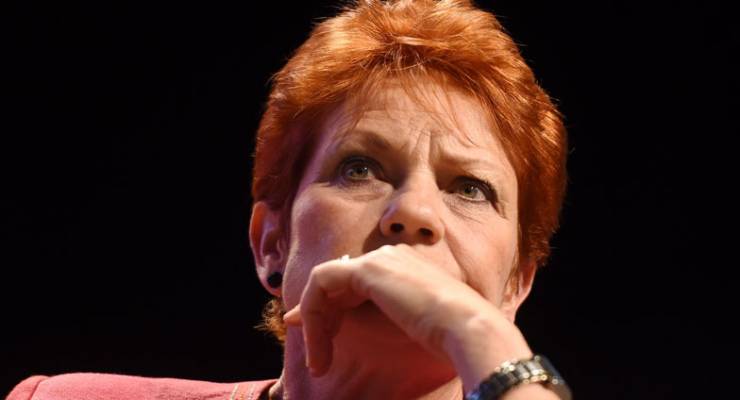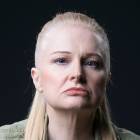
I was watching the telly last night and, just for an instant, Pauline Hanson made some sort of sense. Nothing this bantam horror said made sense, mind; there she was, squawking unfathomably about a rotten, shit-covered moral victory she had laid in the low barnyard of Australian political life, again. It was the ugliness of the noise itself.
Hanson’s is a soulless shriek, whose resonance can only be fully understood just after 30 kids dressed as monsters have come to your door seeking sugar, and just before 100,000 monsters dressed as humans visit Flemington racecourse seeking flat piss. Hanson, like the Straya she claims to know and love, has become so deeply estranged from anything identifiably human, the horror fancy dress of the Cup or of Halloween begin to appear like a uniform.
Of course local women will cram exotic fruit platters in their hair as their escorts sweat in Italian wool and scream for the victims of a bloody sport. Of course local children are dressed like corpses and Donald Trump (there were three nominees last night, and one adorable little witch who told me her “witch name” was Melania). Death and dead hope are the most innocent and true costumes for our era.
These thoughts presented themselves, I should point out, on the downhill slide off a mountain of Kinder chocolate. I wasn’t well before Hanson started her claims that “Strayan people are just fed up with un-Strayan people” and I was very unwell soon after. This person, who is not herself to blame for a nation that is no longer capable of even caring to know what it is, made me reach for the antacids.
It’s a nauseating era, and Hanson is just a finger down the throat. As much as I’d like to believe I have even less in common with that banshee than I do with the patrons of the Cup, I concede her confusion is also mine. She describes the inhuman, profoundly estranged Australia of the present with the purity of a toddler in witch drag. The way this supernatural force invokes our national essence is with the cry, “Un-Australian, un-Australian”. This is her incantation. We only know ourselves now, we only call up our spirit, with recourse to what we’re not.
Back in the first half of the 1990s, before both Pauline Hanson and the culture wars, we used to be able to go to university for pleasure. Thousands of us kids read texts that were not, by any stretch, vocational. You didn’t read Jacques Derrida to get a good job, but just because he seemed a bit loony and interesting. This guy — maligned after his death in 2004 but now enjoying a bit of a narrow comeback — talked a lot about absence. In his reading of language and meaning, we could never utter a truth. Words only meant something because they did not mean something else.
The popular example given to students of the time was that when you said “cat”, you weren’t referring to the animal directly. You were referring only to other things that the cat wasn’t: bat, car, cot etc. Now, I think it’s bullshit to say that this frustrating chain of meaninglessness is the necessary human condition — and I think that Derrida, who became very fond of a particular cat in his dotage, might have been persuaded to agree. But when the idea is applied to our present human — and Australian — condition, it makes a bit of sense.
We can only say we are Australian with constant recourse to what is “un-Australian”. We can’t, even when our future depends on it — and it does — say what makes us us. We can only say what we are not. If you’re a Hanson type, that is not tolerant of asylum seekers, not able to concede that anyone poor is deserving, not fond of wankers who reference Derrida in their fraught Melbourne Cup day essays. If you’re a liberal progressive, you’re now forced into a similar, if opposite, understanding. You are not tolerant of Pauline Hanson. And, of course, the woman is intolerable. But to begin, as we have, to understand our nationhood in terms of what it’s not, even if it’s not Pauline Hanson, is to have no understanding at all.
I know what I want my nation not to be. I don’t want it to stop for a violent, subsidised torture on November’s first Tuesday. I don’t want it to fall into such easy complicity with the US hegemon. I don’t want it to maintain its founding myth of terra nullius. I don’t want its labour movement to roll over and accept the “practicality” of neoliberal organisation.
But, what do I want? Critique, as we kids knew in the first half of the 1990s, is a necessary pleasure, but it only gets you so far. It traps you in a Derridean Halloween nightmare where you just concede that we can never say what something is, or should be. So, what do I want? I’ll start, on this un-Australian day, with something modest: I just want to be able to say, and not in the negative terms of the nationalist, what it means to be Australian.








Well writ. I’d like to think I like the community of includers who only exclude the excluders.
Derrida probably became fond of his cat only because of a growing distaste for everything that was not his cat, specially given how he was forced to reference it all the time and everything. Ditto anyone who is fond of Australia these days. But I have to confess I like the blood sport – on TV, not actually there with the vomiters, fruit and suits.
The Cup & Halloween, a noxious Daily Double.
Beware of Kinder, Helen, apparently not as innocent as they appear to be.
“what it means to be Australian”
Surely the Traditional Owners can help us with this! To be Australian is to be connected to the landscape as a biological, psychological and spiritual system.
Those living above the 20th floor in the inner city may have to spend their weekends working on the connection.
Have you read Whitefella Jump Up? Greer begins to propose this over a long essay. http://www.kooriweb.org/foley/resources/pdfs/143.pdf
A number of indigenous intellectuals have made similar propositions, of course. (Including, Professor Gary Foley, the archivist of the site where the text I directed to you is stored.)
I would say that I think it is possible to live high up in the middle of a city and receive and produce a less alienated version of Australian life. But, can’t be sure as I live in a level rental in an outer suburb.
I have just had a quick scan of Whitefella and am generally in agreement.
When I had a house built in the outer suburbs of Brisbane, I took various types of brick to the land. The land did not like some types. I dare say the land does not like some people. When this occurs people get a sense of an alien and hostile land. The opposite effect I found around Bath UK where the Earth Mother was very strong – Mother England!
The problem seems to be that the whiteman is not the first to damage this landscape. Long before Aboriginal settlement the Australian landscape was traumatised and it has yet to recover.
This affects the emotional structure of Australians. Compare for example a typical white Australian woman with a white French woman.
On the male side, white Australians tend to be teddy bears.
It will take centuries of careful work to recover the people and the land.
As for living high off the ground, it may be unwise to live above tree-top level.
It sometimes strikes me as odd that the chief executor of and apologist for the policy of demonizing the current generation of refugees is called Pezzullo.